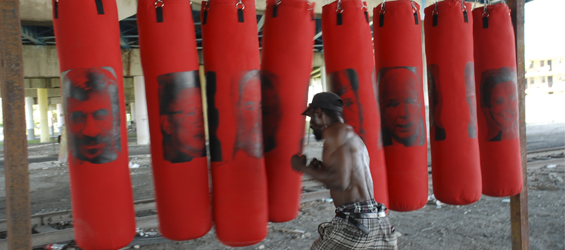Patriotism is defined as a “love of one’s country.” Nationalism is a more complex thing, referring I suppose to one’s nationhood, as distinct from one’s homeland. It’s a topic explored in the new show at MOCCA in Toronto, which opened on Friday, days before the anniversary of September 11, 2001.

ANTUAN, Left or Right, (detail). Image: mocca.ca
Titled Patria o Liberdad! On Patriotism, Immigration and Populism, it is a collection of video art that aims, according to curator Paco Barragan, to address “the complexities of the concept of “nationalism” in a moment in which national identities are being either severely put into question or impetuously vindicated.”

Jen DeNike, Flag Girls, 2007. Image: smith-stewart.com
In his catalogue essay, Barragan proposes “the analogy of “nationalism” with “bad patriotism”, and “good patriotism” as a personal sentiment or love for your roots, language, family etc, that is intimate, not obligatory nor prescriptive…” Essentially, he equates “good patriotism” with love of one’s ethnocultural heritage, and “bad patriotism” with nationalism.

Still from Sometimes it makes me wonder what I fought for, Katri Walker, 2009. Image: VoCA

Still from Sometimes it makes me wonder what I fought for, Katri Walker, 2009. Image: VoCA
I’m not sure I agree with his definition. As is explained HERE, one can also consider patriotism as a love for one’s country and consider nationalism in the cultural or ethnic sense of the word.
I would love to think that in Canada (and much more so in the United States) the two might coexist: patriotism as a love of one’s adopted country, while nationalism as a love for one’s ethnocultural heritage. And they do co-exist among some people. And not for others — Quebec and the separatist movement is one example. It’s a complicated topic and his essay is worth reading HERE.

Still from Ivan Candeo, Inertia, 2009. Image: VoCA
In fact, I enjoyed the essay more than the show itself. To me, the curating felt heavy-handed with little space for the viewer to think. Women unfurling out of an early American flag, courtesy of American artist Jen DeNike; a piece by Cuban artist Antuan showing a man punching bags printed with the faces of various world leaders (Fidel Castro, Hugo Chavez, Osama bin Laden, George Bush…); Ivan Candeo’s Inertia, showing a cyclist on a treadmill in front of a mural of in front of a mural of Bolívar …These were balanced by some more moving piece, particularly Sometimes it makes me wonder what I fought for, by Katri Walker, an intimate study of Jimmy Redpath, an ex-Blackwatch Paratrooper.
A politically-charged show that presented a number of perspectives on a sensitive topic, it asked the viewer for a point of view, while not making it easy — the entire show was video, most of which required headphones.
The exhibition, which has toured to Miami and Amsterdam, will travel to the Stenersen Museum in Oslo next. I wonder how the exhibition locations affect the show’s reception, particularly with Miami and Amsterdam’s fraught relationship to immigrants. A show like this depends on its context — it says as much about the viewer as about the exhibition itself.
Complimenting the show nicely was a fantastic video by the gallery’s entrance, in a screening room sponsored by the National Gallery of Canada. I had seen this work by the excellent polish artist Artur Zmijewski, at Documenta in Kassel, Germany several years ago. Titled THEM, 2007, it documents a group of people brought together in a craft workshop to create images of a ‘symbolic centre’ of Poland. Their clashing ideologies come into play until the ‘artwork’ is burned and eventually thrown out the window.

Still from Artur Zmijewski THEM, 2007. Image: VoCA

Still from Artur Zmijewski THEM, 2007. Image: VoCA

Still from Artur Zmijewski THEM, 2007. Image: VoCA




